Geng Yuan
Harmony in Divergence: Towards Fast, Accurate, and Memory-efficient Zeroth-order LLM Fine-tuning
Feb 05, 2025Abstract:Large language models (LLMs) excel across various tasks, but standard first-order (FO) fine-tuning demands considerable memory, significantly limiting real-world deployment. Recently, zeroth-order (ZO) optimization stood out as a promising memory-efficient training paradigm, avoiding backward passes and relying solely on forward passes for gradient estimation, making it attractive for resource-constrained scenarios. However, ZO method lags far behind FO method in both convergence speed and accuracy. To bridge the gap, we introduce a novel layer-wise divergence analysis that uncovers the distinct update pattern of FO and ZO optimization. Aiming to resemble the learning capacity of FO method from the findings, we propose \textbf{Di}vergence-driven \textbf{Z}eroth-\textbf{O}rder (\textbf{DiZO}) optimization. DiZO conducts divergence-driven layer adaptation by incorporating projections to ZO updates, generating diverse-magnitude updates precisely scaled to layer-wise individual optimization needs. Our results demonstrate that DiZO significantly reduces the needed iterations for convergence without sacrificing throughput, cutting training GPU hours by up to 48\% on various datasets. Moreover, DiZO consistently outperforms the representative ZO baselines in fine-tuning RoBERTa-large, OPT-series, and Llama-series on downstream tasks and, in some cases, even surpasses memory-intensive FO fine-tuning.
Enhancing Visual Inspection Capability of Multi-Modal Large Language Models on Medical Time Series with Supportive Conformalized and Interpretable Small Specialized Models
Jan 27, 2025



Abstract:Large language models (LLMs) exhibit remarkable capabilities in visual inspection of medical time-series data, achieving proficiency comparable to human clinicians. However, their broad scope limits domain-specific precision, and proprietary weights hinder fine-tuning for specialized datasets. In contrast, small specialized models (SSMs) excel in targeted tasks but lack the contextual reasoning required for complex clinical decision-making. To address these challenges, we propose ConMIL (Conformalized Multiple Instance Learning), a decision-support SSM that integrates seamlessly with LLMs. By using Multiple Instance Learning (MIL) to identify clinically significant signal segments and conformal prediction for calibrated set-valued outputs, ConMIL enhances LLMs' interpretative capabilities for medical time-series analysis. Experimental results demonstrate that ConMIL significantly improves the performance of state-of-the-art LLMs, such as ChatGPT4.0 and Qwen2-VL-7B. Specifically, \ConMIL{}-supported Qwen2-VL-7B achieves 94.92% and 96.82% precision for confident samples in arrhythmia detection and sleep staging, compared to standalone LLM accuracy of 46.13% and 13.16%. These findings highlight the potential of ConMIL to bridge task-specific precision and broader contextual reasoning, enabling more reliable and interpretable AI-driven clinical decision support.
RoRA: Efficient Fine-Tuning of LLM with Reliability Optimization for Rank Adaptation
Jan 08, 2025



Abstract:Fine-tuning helps large language models (LLM) recover degraded information and enhance task performance.Although Low-Rank Adaptation (LoRA) is widely used and effective for fine-tuning, we have observed that its scaling factor can limit or even reduce performance as the rank size increases. To address this issue, we propose RoRA (Rank-adaptive Reliability Optimization), a simple yet effective method for optimizing LoRA's scaling factor. By replacing $\alpha/r$ with $\alpha/\sqrt{r}$, RoRA ensures improved performance as rank size increases. Moreover, RoRA enhances low-rank adaptation in fine-tuning uncompressed models and excels in the more challenging task of accuracy recovery when fine-tuning pruned models. Extensive experiments demonstrate the effectiveness of RoRA in fine-tuning both uncompressed and pruned models. RoRA surpasses the state-of-the-art (SOTA) in average accuracy and robustness on LLaMA-7B/13B, LLaMA2-7B, and LLaMA3-8B, specifically outperforming LoRA and DoRA by 6.5% and 2.9% on LLaMA-7B, respectively. In pruned model fine-tuning, RoRA shows significant advantages; for SHEARED-LLAMA-1.3, a LLaMA-7B with 81.4% pruning, RoRA achieves 5.7% higher average accuracy than LoRA and 3.9% higher than DoRA.
Fast and Memory-Efficient Video Diffusion Using Streamlined Inference
Nov 02, 2024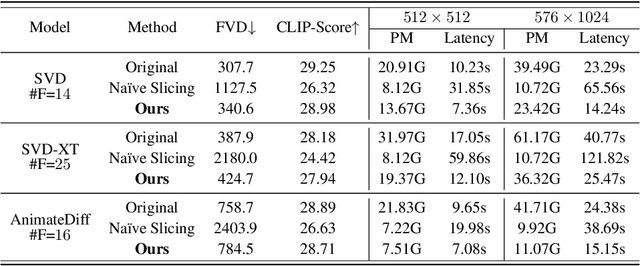
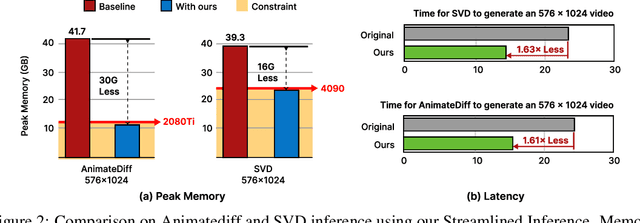

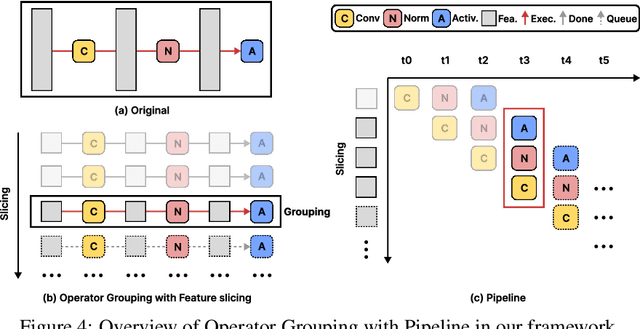
Abstract:The rapid progress in artificial intelligence-generated content (AIGC), especially with diffusion models, has significantly advanced development of high-quality video generation. However, current video diffusion models exhibit demanding computational requirements and high peak memory usage, especially for generating longer and higher-resolution videos. These limitations greatly hinder the practical application of video diffusion models on standard hardware platforms. To tackle this issue, we present a novel, training-free framework named Streamlined Inference, which leverages the temporal and spatial properties of video diffusion models. Our approach integrates three core components: Feature Slicer, Operator Grouping, and Step Rehash. Specifically, Feature Slicer effectively partitions input features into sub-features and Operator Grouping processes each sub-feature with a group of consecutive operators, resulting in significant memory reduction without sacrificing the quality or speed. Step Rehash further exploits the similarity between adjacent steps in diffusion, and accelerates inference through skipping unnecessary steps. Extensive experiments demonstrate that our approach significantly reduces peak memory and computational overhead, making it feasible to generate high-quality videos on a single consumer GPU (e.g., reducing peak memory of AnimateDiff from 42GB to 11GB, featuring faster inference on 2080Ti).
Brain Tumor Classification on MRI in Light of Molecular Markers
Sep 29, 2024



Abstract:In research findings, co-deletion of the 1p/19q gene is associated with clinical outcomes in low-grade gliomas. The ability to predict 1p19q status is critical for treatment planning and patient follow-up. This study aims to utilize a specially MRI-based convolutional neural network for brain cancer detection. Although public networks such as RestNet and AlexNet can effectively diagnose brain cancers using transfer learning, the model includes quite a few weights that have nothing to do with medical images. As a result, the diagnostic results are unreliable by the transfer learning model. To deal with the problem of trustworthiness, we create the model from the ground up, rather than depending on a pre-trained model. To enable flexibility, we combined convolution stacking with a dropout and full connect operation, it improved performance by reducing overfitting. During model training, we also supplement the given dataset and inject Gaussian noise. We use three--fold cross-validation to train the best selection model. Comparing InceptionV3, VGG16, and MobileNetV2 fine-tuned with pre-trained models, our model produces better results. On an validation set of 125 codeletion vs. 31 not codeletion images, the proposed network achieves 96.37\% percent F1-score, 97.46\% percent precision, and 96.34\% percent recall when classifying 1p/19q codeletion and not codeletion images.
* ICAI'22 - The 24th International Conference on Artificial Intelligence, The 2022 World Congress in Computer Science, Computer Engineering, & Applied Computing (CSCE'22), Las Vegas, USA. The paper acceptance rate 17% for regular papers. The publication of the CSCE 2022 conference proceedings has been delayed due to the pandemic
Efficient Pruning of Large Language Model with Adaptive Estimation Fusion
Mar 16, 2024Abstract:Large language models (LLMs) have become crucial for many generative downstream tasks, leading to an inevitable trend and significant challenge to deploy them efficiently on resource-constrained devices. Structured pruning is a widely used method to address this challenge. However, when dealing with the complex structure of the multiple decoder layers, general methods often employ common estimation approaches for pruning. These approaches lead to a decline in accuracy for specific downstream tasks. In this paper, we introduce a simple yet efficient method that adaptively models the importance of each substructure. Meanwhile, it can adaptively fuse coarse-grained and finegrained estimations based on the results from complex and multilayer structures. All aspects of our design seamlessly integrate into the endto-end pruning framework. Our experimental results, compared with state-of-the-art methods on mainstream datasets, demonstrate average accuracy improvements of 1.1%, 1.02%, 2.0%, and 1.2% for LLaMa-7B,Vicuna-7B, Baichuan-7B, and Bloom-7b1, respectively.
SmartFRZ: An Efficient Training Framework using Attention-Based Layer Freezing
Jan 30, 2024



Abstract:There has been a proliferation of artificial intelligence applications, where model training is key to promising high-quality services for these applications. However, the model training process is both time-intensive and energy-intensive, inevitably affecting the user's demand for application efficiency. Layer freezing, an efficient model training technique, has been proposed to improve training efficiency. Although existing layer freezing methods demonstrate the great potential to reduce model training costs, they still remain shortcomings such as lacking generalizability and compromised accuracy. For instance, existing layer freezing methods either require the freeze configurations to be manually defined before training, which does not apply to different networks, or use heuristic freezing criteria that is hard to guarantee decent accuracy in different scenarios. Therefore, there lacks a generic and smart layer freezing method that can automatically perform ``in-situation'' layer freezing for different networks during training processes. To this end, we propose a generic and efficient training framework (SmartFRZ). The core proposed technique in SmartFRZ is attention-guided layer freezing, which can automatically select the appropriate layers to freeze without compromising accuracy. Experimental results show that SmartFRZ effectively reduces the amount of computation in training and achieves significant training acceleration, and outperforms the state-of-the-art layer freezing approaches.
EdgeOL: Efficient in-situ Online Learning on Edge Devices
Jan 30, 2024
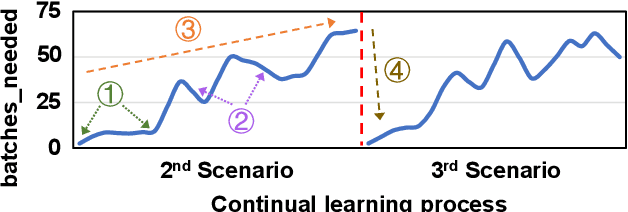

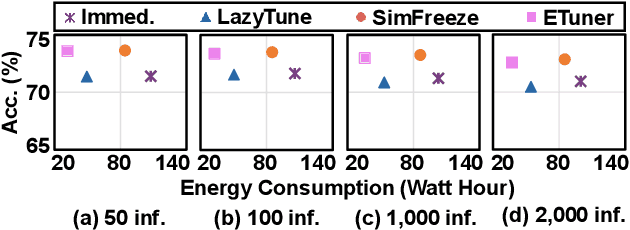
Abstract:Emerging applications, such as robot-assisted eldercare and object recognition, generally employ deep learning neural networks (DNNs) models and naturally require: i) handling streaming-in inference requests and ii) adapting to possible deployment scenario changes. Online model fine-tuning is widely adopted to satisfy these needs. However, fine-tuning involves significant energy consumption, making it challenging to deploy on edge devices. In this paper, we propose EdgeOL, an edge online learning framework that optimizes inference accuracy, fine-tuning execution time, and energy efficiency through both inter-tuning and intra-tuning optimizations. Experimental results show that, on average, EdgeOL reduces overall fine-tuning execution time by 82%, energy consumption by 74%, and improves average inference accuracy by 1.70% over the immediate online learning strategy.
Zero-Space Cost Fault Tolerance for Transformer-based Language Models on ReRAM
Jan 22, 2024Abstract:Resistive Random Access Memory (ReRAM) has emerged as a promising platform for deep neural networks (DNNs) due to its support for parallel in-situ matrix-vector multiplication. However, hardware failures, such as stuck-at-fault defects, can result in significant prediction errors during model inference. While additional crossbars can be used to address these failures, they come with storage overhead and are not efficient in terms of space, energy, and cost. In this paper, we propose a fault protection mechanism that incurs zero space cost. Our approach includes: 1) differentiable structure pruning of rows and columns to reduce model redundancy, 2) weight duplication and voting for robust output, and 3) embedding duplicated most significant bits (MSBs) into the model weight. We evaluate our method on nine tasks of the GLUE benchmark with the BERT model, and experimental results prove its effectiveness.
MTS-LOF: Medical Time-Series Representation Learning via Occlusion-Invariant Features
Oct 19, 2023Abstract:Medical time series data are indispensable in healthcare, providing critical insights for disease diagnosis, treatment planning, and patient management. The exponential growth in data complexity, driven by advanced sensor technologies, has presented challenges related to data labeling. Self-supervised learning (SSL) has emerged as a transformative approach to address these challenges, eliminating the need for extensive human annotation. In this study, we introduce a novel framework for Medical Time Series Representation Learning, known as MTS-LOF. MTS-LOF leverages the strengths of contrastive learning and Masked Autoencoder (MAE) methods, offering a unique approach to representation learning for medical time series data. By combining these techniques, MTS-LOF enhances the potential of healthcare applications by providing more sophisticated, context-rich representations. Additionally, MTS-LOF employs a multi-masking strategy to facilitate occlusion-invariant feature learning. This approach allows the model to create multiple views of the data by masking portions of it. By minimizing the discrepancy between the representations of these masked patches and the fully visible patches, MTS-LOF learns to capture rich contextual information within medical time series datasets. The results of experiments conducted on diverse medical time series datasets demonstrate the superiority of MTS-LOF over other methods. These findings hold promise for significantly enhancing healthcare applications by improving representation learning. Furthermore, our work delves into the integration of joint-embedding SSL and MAE techniques, shedding light on the intricate interplay between temporal and structural dependencies in healthcare data. This understanding is crucial, as it allows us to grasp the complexities of healthcare data analysis.
 Add to Chrome
Add to Chrome Add to Firefox
Add to Firefox Add to Edge
Add to Edge